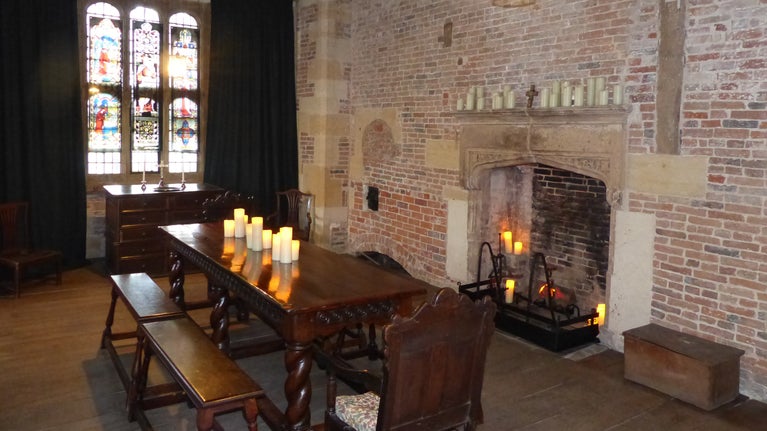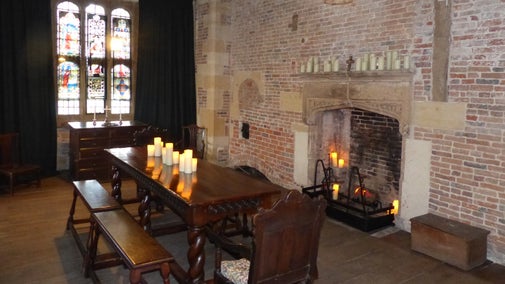
Discover more at Coughton Court
Find out when Coughton Court is open, how to get here, things to see and do and more.

Coughton Court has been home to the Throckmorton family for over six centuries, and they still live here today. On a visit to Coughton, you can wander around most of the house, enjoy the fascinating collections and discover some of the family's secrets.
Coughton Court is now closed for winter. We look forward to welcoming you back on 15 March 2025.
We now have a dedicated page 'Through the Roof Project - Future pROOFing Coughton' which we be updating regularly with news and updates on the projects as they progress as well as updates on what you can expect from your visit.
Every penny spent at Coughton helps us to look after and support the care of this special place. Thank you for your support.
From the 29 February visitors are invited to immerse themselves into the new interactive Through the Roof exhibition. Located in the Coach House visitors can dive deeper into the £3.3 million project learning all about the behind the scenes secrets. Hear from the experts that are supporting the project in the new behind the scenes video. Explore life as a Coughton Court bat in the new bat cave complete with sounds and smells. Get up close to various samples used from the project including bricks, slates and tiles. Plus there are plenty of interactive activities all ages can get involve with including finding the historical people on the Tabular, taking part in the Coughton Court coin drop and making your very own Coughton Court bat to take home.

Please be aware that due to the Through the Roof project some of the rooms in the house have been displayed in new ways. To explore more about the Through the Roof: FuturepROOFing Coughton Court project head over to our dedicated page Through the Roof: FuturepROOFing Coughton Court | National Trust
The open rooms share stories of each generation that lived in the house and cared for Coughton, sharing stories that may not have been heard before. Below are the open rooms and highlights to look out for during your visit.
The Front Hall is the start of a visit to the house at Coughton. It originally served as the gatehouse passageway and was open at both ends.
In the 1780s, the 4th Baronet turned it into a room decorated in the Gothic style. The ceiling was given a fine fan vault and the walls lined out to resemble masonry, although the whole effect was in fact created from plaster rather than stone.
On your visit, you may be lucky enough to hear the longcase clock chime. It was a 21st birthday present to Sir Robert Throckmorton, 11th Baronet, in 1929.
The Panelled Dining Room has been transformed into portrait store for the duration of the project for their protection.
The new house experience now opened allows visitors investigate and learn about the people that lived at Coughton Court and transformed the architecture to what it can been seen as today. Explore the Panelled Dining Room absorb the information about the people and the collection in more detail. Have fun with interactive activities for all ages and don't forget to share your historical dress up pictures with us. The activities now include the opportunity to make your own origami bat with the paper and folding instructions provided.

We are happy to announce that the Tower Room has now re-opened. The room has been designed to reflect its history as a space that would have been used by the family to practice their religion. With the priest hole situated in this room already, we want to focus on these features of religiosity. As the room is an inaccessible space to many, we wanted to focus on the stories this room already offers.
We have created stained glass on Perspex from reference images from both churches. Additionally, we are including Tudor church music and frankincense in order to draw on as many senses as possible to evoke feelings of calm and reflection.
By dressing the room in this way, we hope visitors can use this space to reflect on how significant the Catholic faith was to the Throckmorton’s, the lengths they sought to defend their faith and the dangers of them doing so.
The refectory table has been put back, with plenty of room for visitors to sit and enjoy a different space.

The saloon has become the home to Coughton Courts chandeliers; there are 4 chandeliers from different parts of the house to protect them while the Through the Roof project is taking place. This has allowed visitors to get up close to the delicate chandeliers to witness them being conserved by the House and Collections team but also watch them sparkle in a new light display.

Please be aware that due to the Through the Roof project some of the rooms in the house are looking a little different right now. To explore more about the Through the Roof: FuturepROOFing Coughton Court head over to our dedicated page Through the Roof: FuturepROOFing Coughton Court | National Trust
The staircase acts as a family tree, with many portraits showing several generations of the Throckmorton family. The earliest are at the bottom and the later generations are shown nearer the top.
The portrait straight ahead as you climb the first flight is of Katherine Vaux who with her husband, Sir George Throckmorton, had 19 children and 112 grandchildren.
Specialist movers have been busy moving all the paintings from the staircase back into place. They look really good against the newly painted walls.
In Elizabethan times, this was probably the great chamber, the principal first-floor reception room, where the Throckmorton's would have entertained important guests.
The room is thought to have become the Dining Room in the early nineteenth century, which cannot have been popular with the household staff, as the kitchen was almost 100 metres away at the opposite corner of the building. Look out for the sixteenth century panelling and oak dole-gate from the convent of Denny.
This room embodies the Throckmorton family’s journey from danger to triumph. Throughout the 1500s and 1600s, the Catholic relics that can be seen here would have been hidden away from public view. Their discovery would have put their owners’ lives at certain risk.
With Catholic Emancipation in 1829, the family were at last free to display their beliefs and their treasures openly, for all to see.
In the Tudor house this was the great hall, where the whole household would have gathered to eat or be entertained on special occasions. It served as a covert chapel between 1688, when the east wing was ransacked, and 1855, when the Catholic chapel in the park was completed.
The portraits are largely of nineteenth and twentieth century Throckmorton's including Sir John Throckmorton. This room is still used for family celebrations and is also used by the National Trust for functions. The famous Throckmorton coat can be found in here.
The Blue Drawing Room is on the first floor of the gatehouse, the oldest surviving part of Coughton Court. When new in the 1530s, it would have been one of the most important rooms in the house. Following the roofing project the Blue Drawing Room has been restored to it's former glory. It has been re-opened and is now being used for a Gunpowder plot display which is full of information about the plot and the part that Coughton Court played in it.
Legend has it that on the 6 November 1605 Lady Digby, the young wife of Gunpowder Plot collaborator, Sir Everard, two Jesuit priests, Fathers Garnet and Tesimond and Nicholas Owen, the man who built the priest hole in the tower, sat in this room waiting to hear the outcome of the conspiracy.

The Tapestry Bedroom is part of the extension added to the main house by Sir Francis Throckmorton (2nd Baronet) during the late 1600s. Sir Francis inherited Coughton when he was just 9 years old.
Look out for the huge wardrobe known as an armoire, made from walnut during the 1600s, the half tester bed, made from mahogany dating to the Victorian period and the tapestry fragments.

Find out when Coughton Court is open, how to get here, things to see and do and more.

Coughton Court is home to a number of historic items. Take a closer look at two of the most important items in the collection – the Throckmorton coat and the Tabula Eliensis.

Twenty-one generations of the Throckmorton family have lived at Coughton since 1409. Over six centuries there are many stories to tell, including that of the gunpowder plot. The family were related to the key conspirators in the Gunpowder Plot, an effort to end the persecution of Catholics. The ringleader of the Gunpowder Plot was Robert Catesby, a charismatic and forceful character, and the son of Sir William Catesby and his wife Anne, daughter of Sir Thomas Throckmorton of Coughton Court.

The Throckmorton family created and manages the award-winning garden at Coughton. Highlights include the walled garden, lake, knot garden, vegetable garden, orchard and bog garden.

Caring for Coughton goes on all year round, much of it behind the scenes. Find out more about the work being done to protect and restore Coughton and its treasures.

Visit Coughton Court for family-friendly events and activities in the house and garden, including woodland walks and wildlife spotting.

Find out more about why there are two churches at Coughton Court and the story they have to tell of the Throckmorton family’s persecution for their adherence to the Catholic faith.

Historic buildings are a treasure trove of stories, art and collections. Learn more about their past and plan your next visit.

Discover the historic houses and buildings around Warwickshire, from secluded forest houses to grand rural retreats from the Tudor and Victorian eras.